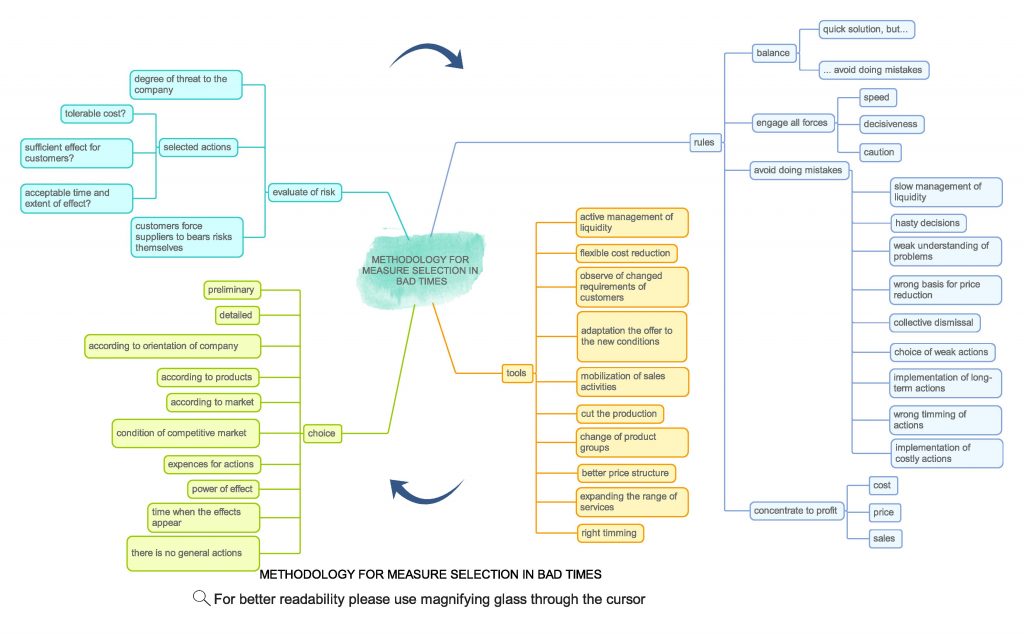Every company is different.
It has other people, other products or services, it has a different size, it has different customers, it operates in a different branch, in a different place and in different conditions.
It may be that one company is still doing well in the crisis, even better than before the crisis, and another company is doing worse, even so badly, that it is struggling to survive.
That´s why we approach every company individually and respect its specific state and canditions in which it works.
Working methods should be selected sensitively and carefully.
As an inspiration, we offer several views of crisis problems and their solutions in the form of an mind map.

The analysis of the 2008-2009 crisis showed that several companies reacted too late to the deterioration of external conditions. There was a delay in the range of 3-6 months.
The following behavior of companies was also typical in the initial phase of the crisis.
It was often the belief in companies that “this is not a problem of our company, but especially of other companies.”
Companies began to respond only after orders fell by 10%.
The companies started implementing measures in the area of reducing personnel costs, and in other difficult-to-implement areas, only after a decrease in production by 20-30%, which was too late.

An analogous pattern of behavior is constantly repeated. Although it is widely acknowledged that there will be a crisis after a boom, companies are usually not prepared for a crisis. Cash reserves are too small or non-existent, and no crisis scenarios for possible events are created. It’s a bit like a joke with road maintenance which is surprised by every winter when it is snowing for the first time.
It can be very useful for the members of the company´s management to monitor and evaluate the development of the situation regulary. This “early warning system” would serve as an incentive for quick selection and action.
At the same time, you must take into account that in difficult times, people respond more sensitively to external sensors. They lose faster positive emotions, which are a necessary condition for good performance of challenges in difficult conditions.
Loyal workers involved in the overall situation who live with the company are a great advantage in times of crisis and the only guarantee that the company will overcome difficult times. In good times, people led in this way provide the company with better work and higher added value through greater interest, new thoughts, ideas and innovations. In bad times, there is little chance of a sufficiently rapid change in the nature and level of employment relationships. This takes longer.
The fact is that in times of crisis, people are more sensitive and willing to take into things that we have really rejected in good times.
Maybe ever at bad times, the possibility is offered to start a new approach to build better intermediate relations.
Especially if the drop in orders has caused less workload for daily tasks, but they remain in the company because you want to keep them. Tighten up a few systematic things that have shifted in the boom and now there is more time for them.
It depends on the current conditions in which the company is located. The circumstances need to be carefully considered – the time and resources to be spent and, on the other hand, the benefits that can be expected from such a solution.
It is better to fill unusable working hours by training and solving longer-term projects than to let people sit.
It can be beneficial to invest in people even at wrong times to work better in their greater capacity and willingness through building a system of continuous improvement.
For most companies, more small improvements will be more beneficial than large and long-term improvement projects.
Even a small improvement counts, both in good and bad times. Perhaps most importantly, the improvement process is still running, not interrupted. Restarting activities is much more difficult than keeping activities running.
If you are interested in the METHODS – FOR “BAD TIMES” section, see also the PROJECTS – FOR “BAD TIMES” section, as they complement each other.